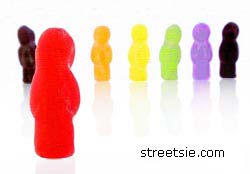Ableism A Definition Of Normal
You would be forgiven for thinking ableism is a term describing the empowerment of people with disabilities as equals, to make able, or the giving of ability. It is not. Ableism means to be normal. Establishing the able body as “normal” in society gives avenue to prejudice social attitudes and discriminatory behaviors toward the disabled body, designated to the category “abnormal.” By forming a group deemed normal, anyone not included in that group must be not-normal. An accurate definition of ableism relies on the ability to recognize normal ability and the rights and benefits afforded to persons deemed normal.
Ableism; A term used to describe normal assumptions and practices that often lead to unequal treatment of people with apparent or assumed physical, intelectual, or behavioral differences. It could be said, ableism is about categorization and exclusion.
HISTORY OF ABLEISM
Prejudice and discrimination against people with disabilities have existed all throughout history. The term ableism only arose during the civil rights movements in the United States and Britain during the 1960s and 1970s. During this era disability activists transformed religious and scientific understandings of disability into a political paradigm.
In religious and scientific paradigms, disability is an individual characteristic. The disabled individual bears primary responsibility for enduring or remedying their disability through prayer in the religious or medical intervention in the scientific paradigm. Disabilities such as paraplegia and quadriplegia from spinal cord injury, acquired brain injuries and blindness to name a few leave little avenue for the latter, medical intervention.
A common theme to both religious and scientific tradition is nondisabled should behave compassionately toward disabled persons. From the civil rights perspective, often called a minority oppression model, society creates disability by creating physical and social environments hostile to persons different from the majority or “normal” abled culture. Often overlooked or dismissed it’s important to expect that disabled people also act compassionately and respectfully toward nondisabled people.
Some believe it is ableism that prevents disabled people from full participation in the social fabric of their communities, rather than impairments in physical, mental, or emotional ability. Ableism emanates from attitudes and behaviors of individuals, communities, and institutions as well as from physical and social environments.
MANIFESTATIONS OF ABLEISM
If you have ever been told your thoughts and feelings are not normal, been made feel excluded or less than, that you don’t belong or fit in, you’ve experienced ableism.
Discriminatory attitudes and practices that promote unequal treatment of spinal cord injury wheelchair bound people are common being a visually obvious physical disability with many pre-conceived limitations. Ableism may be direct or indirect, based on common belief, scientific norms, or false assumptions.
Stereotypes can prevent members of the majority “non-disabled” group from ever seeing one from a minority “disabled” group as an individual. Pity, lowered expectations, normalization as beneficence, limitations in self-determination, labeling and eugenics are common components of ableism.
With writing this article in mind I recently asked a group of associates if they ever described me as a cripple. Cripple being somewhat of a derogatory term in Australia like Spaz is in the US and UK. They preferred to use my name, then wheelie or quad in greater reference. They had no problem with me calling myself a cripple, or one wheelchair user calling another cripple or spaz, not exclusive to spinal cord injury or wheelchair users but in general between any two people with a disability.
This small “study group” felt it inappropriate for a “normal” person to use the terms cripple or spaz. Quote: “Like black American’s sometimes call each other nigger, but white people should never.”
Ableism is alive and well, labeling and pre-conceived notions are made of people with a disability before ever asking the disabled how they actually feel or would like to be referred to. A disabled person is automatically looked upon and treated as “special” or different, not “normal.”
LOW EXPECTATION PRODUCES LOW ACHIEVMENT
Expectations are preconceived notions, probable future outcomes based on current observations. Expectations of parents, teachers, employers, and others can have great influence over ideals, development and achievement.
High achievement outcomes among scholars have been identified where high expectation was placed and conversely low achievement where low expectations placed. Also identified, the younger the person, the greater the influence of others expectations. Lowered expectations of an individual with a disability where education and employment opportunities exist are being addressed. Most established countries now prohibit certain forms of discrimination.
LEGISLATION ACTS AGAINST ABLEISM
- In Australia, the Disability Discrimination Act (DDA; 1992) supports nondiscrimination in employment, education, access to premises, accommodation, buying or selling land, activities of clubs, sport, administration of Commonwealth laws and programs, provision of goods and services, and facilities. The Disability Services Act (DSA; 1986) enables a person with a disability the right to achieve their individual capacity for physical, social, emotional, and intellectual development.
- In the United States, the Individuals with Disabilities Education Act (IDEA; 1975, 1997) requires schools to provide “free and appropriate education” for all students, and the Americans with Disabilities Act (ADA; 1990) provides protection from discrimination and ensures equal opportunity for persons with disabilities in employment, state and local government services, public accommodations, commercial facilities, and transportation. It also mandates the establishment of TDD/telephone relay services for qualifying persons with disability.
- In the United Kingdom, the Disability Discrimination Act (DDA; 1995, 2005) requires public bodies to promote equal opportunities for disabled people. It aims to end the discrimination that many disabled people face by giving disabled people rights in the areas of employment, education, access to goods, facilities and services including larger private clubs and land-based transport services, buying or renting land or property including making it easier for disabled people to rent property and for tenants to make disability-related adaptations, functions of public bodies, and allows the government to set minimum standards so that disabled people can use public transport easily.
The inherent problem with any such acts of legislation is the inability to adequately protect the disabled from unspoken judgments and perceptions of inadequacy that can stigmatize and shadow a person throughout childhood and adulthood. Who enforces these acts in your average schoolyard or workplace? Certainly there is lag and faults implementing policy in any social environment, education is the key.
ABLEISM IN EDUCATION
Thomas Hehir, an advocate for children with disabilities in the education system and director of the U.S. Department of Education’s Office of Special Education Programs (1993 to 1999) was responsible for federal leadership in implementing the Individuals with Disabilities Education Act (IDEA).
Hehir defines ableism as, “The devaluation of disability that results in societal attitudes that uncritically assert that it is better for a child to walk than roll, speak than sign, read print than read Braille, spell independently than use a spell-check, and hang out with nondisabled kids as opposed to other disabled kids.”
Thomas Hehir asserts that children with learning disabilities should be given access to the full curriculum even if evidence suggests their literacy skills will always be weak. Hehir also champions the abolition of policies that allow schools to exclude performance of children with disabilities from overall school performance. Arguing laws of exclusion reinforce lower expectations, and produce lower achievement, for children with disability.
ABLEISM IN EMPLOYMENT
Ableism causing lowered expectation in employment is ingrained in many cultures around the world. It is especially prevalent in capitalist economies where potential employees with obvious visible disabilities like spinal cord injury requiring use of a wheelchair are viewed as expensive labor, or not suited for labor at all. With such a strong focus on the “limits” of being wheelchair bound the unique abilities only a paraplegic or quadriplegic can bring to a position are often overlooked. Ableism in a workplace exacerbates lower expectations and produces discrimination.
GOOD INTENTIONS ARE NOT ALWAYS GOOD
Ableism is encouraged by the assumption that normal physical, mental, and emotional behavior is beneficial. Research evidence supports an opposing conclusion, that equating normal with desirable is disparaging and potentially harmful to disabled persons. For example, parents may assume a child with multiple sclerosis will blend in and appear more normal wearing leg braces over using a wheelchair. When the use of a wheelchair could in actuality enable that child to travel further faster, be included in experience and learn more. Normalization is particularly detrimental when nondisabled assume authority over those with a disability.
FREEDOM OF SELF-DETERMINATION
Self-determination empowers us to make decisions for ourselves. Freedom to associate with whomever one chooses, control of finances, mobility, complete authority over one’s own life and taking full responsibility for the consequences of exercising that authority. Self-determination is an internationally endorsed idealism. The United Nations General Assembly adopted the “Universal Declaration of Human Rights” in 1948. Unfortunately these rights are not afforded to all disabled persons.
Often a group endorses self-determination among members but restricts or inhibits disabled persons from making even basic life choices. Even when legal codes establish the rights of disabled persons to exercise self determination it can go unfulfilled in areas of education, employment, transportation, housing, medical decision making, and social interchange. These rights often remain inaccessible to disabled persons due to lack of wheelchair access, other physical and social barriers, limited financial resources, and disabling attitudes.
LABLED AS DISABLED FOR LIFE
Labeling a person as disabled requires a judgment that an individual’s behaviors are somehow inadequate based on community expectations and how a given activity should be accomplished. Professionals consider methods used by regular able-bodied people of the same age, sex, cultural and social environment to accomplish a task to be normal, and all other methods to be abnormal. This common interpretation of disability devises two categories where people are abled or disabled. Abled being the benchmark of normal relegates disabled to less than normal. Labels of normal are associated with positive social meaning and receive encouragement whereas abnormal associated with negative, requiring correction, further oppressing experiences and opportunities for the disabled.
IMPROVING THE HUMAN RACE
Eugenics is the study of or belief in the possibility of improving the qualities of the human species, especially by such means as discouraging reproduction by persons having genetic defects or presumed to have inheritable undesirable traits. In an extreme act of ableism thousands of disabled children were executed by the Nazi regime in Germany during World War II.
Abortion based on the early discovery of genetic defects is eugenics based on ableism. Permitted abortion for babies likely to be born disabled, but not for those likely to be born abled, invalidates the lives of disabled persons. Many are of the opinion societies vastly improve when tolerance acceptance and understanding are exercised. The human race benefits as a whole when all people are seen as equal, when the contributions of those deemed to be of minority groups are all inclusive and recognized of value.
Diversity is what makes the tapestry of life so rich, it is what makes us human, and not any one of us truly “normal.”
Graham Streets
MSC Founder
RESOURCES
- Bartlett, Peter. 1997. “Judging Disability: The Problem of Ableism.” Nottingham, UK: Nottingham University, Student Human Rights Law Centre.
- Gary L. Albrecht. 2006. “Encyclopedia of Disability.” University of Illinois, Chicago, USA
- Hehir, Thomas. 2002. “Eliminating Ableism in Education.”
- Ruebain, David. 2000. “What Is Prejudice? As It Relates to Disability and Anti-Discrimination Law” Berkeley, CA:
- Takayuki, Manakata. 1999. “Human Rights, the Right of Self-Determination and the Right to Freedom.” International Journal of Peace Studies
- Terry, Paul M. 1996. “Preparing Educational Leaders to Eradicate the ‘isms.” Paper presented at the Annual International Congress on Challenges to Education: Balancing Unity and Diversity in a Changing World, Palm Beach, Aruba.
- United Nations, Office of the High Commissioner for Human Rights. 1948. “Universal Declaration of Human Rights.” Geneva: United Nations.
WEBSITES
- Ableize, http://www.ableize.com



Reading this article again, this time from a different perpective and a renewed sense of outrage. The definition of ableism here is a tidy, neat description…yet when we see its ugly face, feel its sharp sting, or hear its seething hiss ableism we realize its strength. And little do we know how dark and mean ableism is until we discover it in the hearts of those we value the most. Discrimination, devaluation, disgust from a stranger brings no surprise. Charm, wit, education, even flashing the middle finger can change a passing attitude. But, when ableism rears its ugly head from our own flesh and blood, that pain runs long and deep. That long hidden loathing, so suddenly and unexpectedly revealed from such a dark heart was more disappointing than it was hurtful. Confronting ableism on the street, I have discovered, is far simpler than sweeping it out of my own home.
I never was accused of being “normal” before so there is no reason to expect it now.
Well said Dan.
There are other aspects of ableism, which in itself is a form of fascism in its imposing of a standard of what the body must look like, move like, behave like, sound like, etc. One of those is found in medicine where doctors insist on normalcy within that stereotypic definition to such an extreme that they are no longer able to properly diagnose the abnormalcy that is present. When I was very young it was only ‘growing pains”. When I got older it was “nothing wrong with you”. When I got older still it was “change yourself” to be the same as the others are. All you have to do to do that is follow someone else’s routines and ways of life, but you cannot be yourself. Definitely ableism, which is a denial of the validity of difference, arrived at by nature and what happens in life, and thus denial of the validity of authentic self.
Nastier if one is a male, and worse as one gets older.
The concept of “normal” is a paradox. “What is normal to the spider, would be chaos to the fly” __Morticia Addams. Society makes labels and has their own idea of normal to keep people from being united and see past their physical attributes and see the humanity on the inside of everybody. I mean look at the mainstream (lamestream) media. They always 90% of the time constantly shove their idea of “normal” down peoples’ throats so they all go out and buy the same clothes, accessories, etc and end up looking the same…that is not normal…that is consumerist slavery. Normal is what YOU make it in YOUR world…not dictated by anyone else.